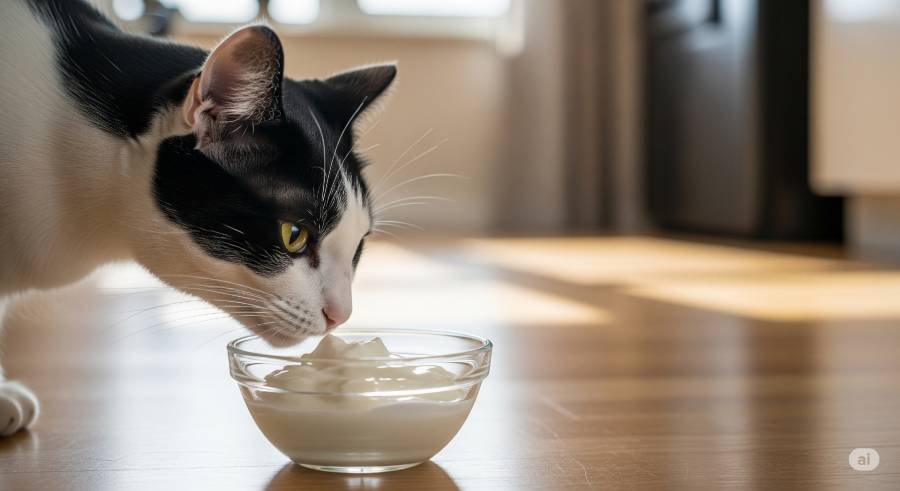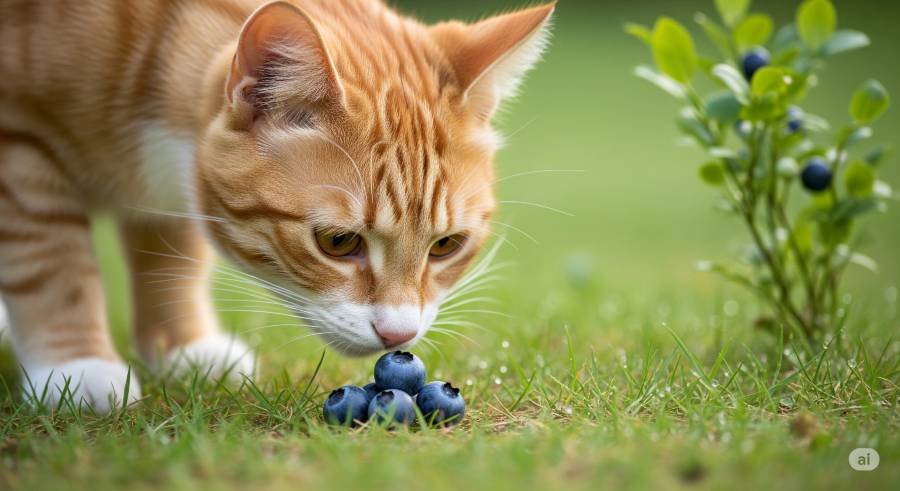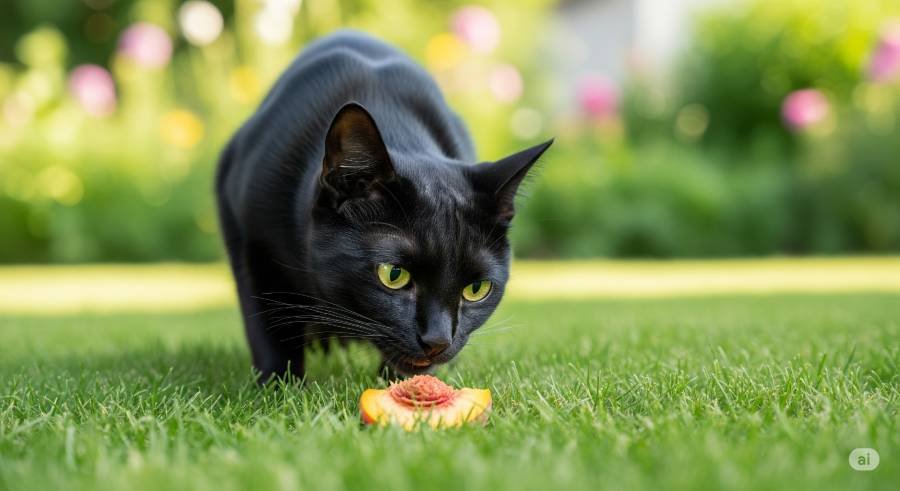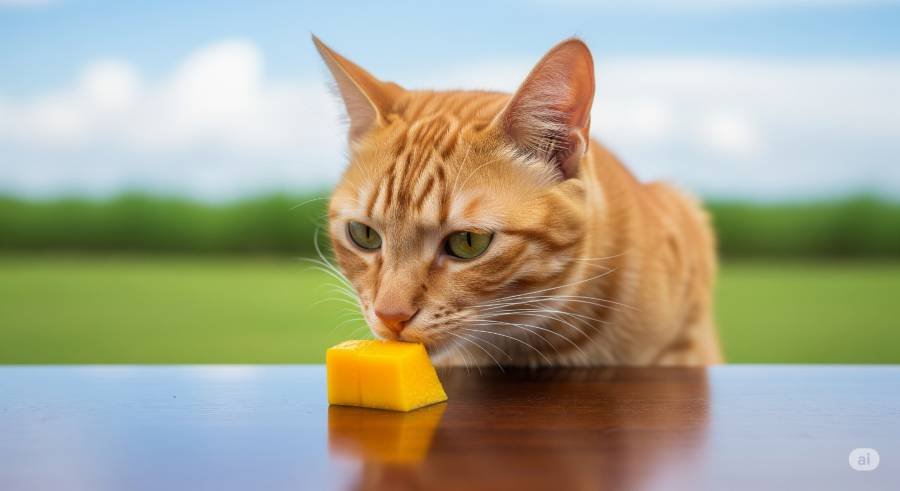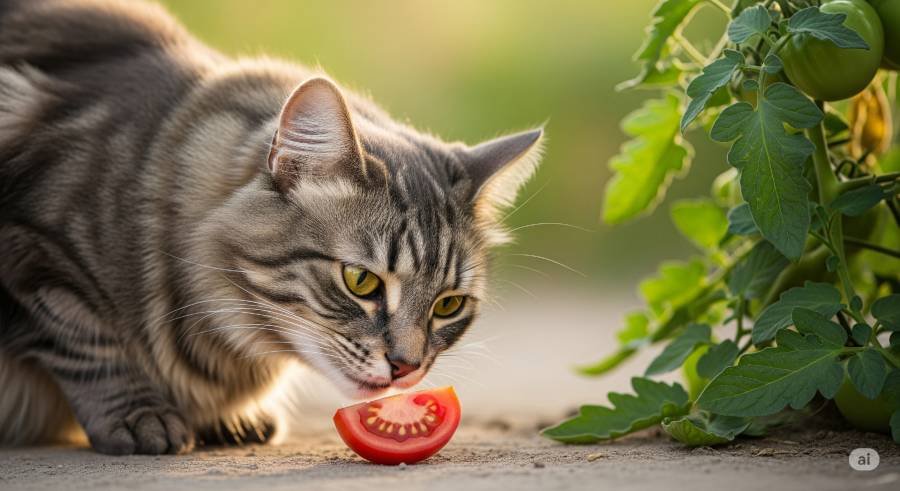Yes, cats can eat some fruits in small amounts, but not all fruits are safe for them. While cats are obligate carnivores and their diet should primarily consist of meat, certain fruits can be offered as occasional treats.
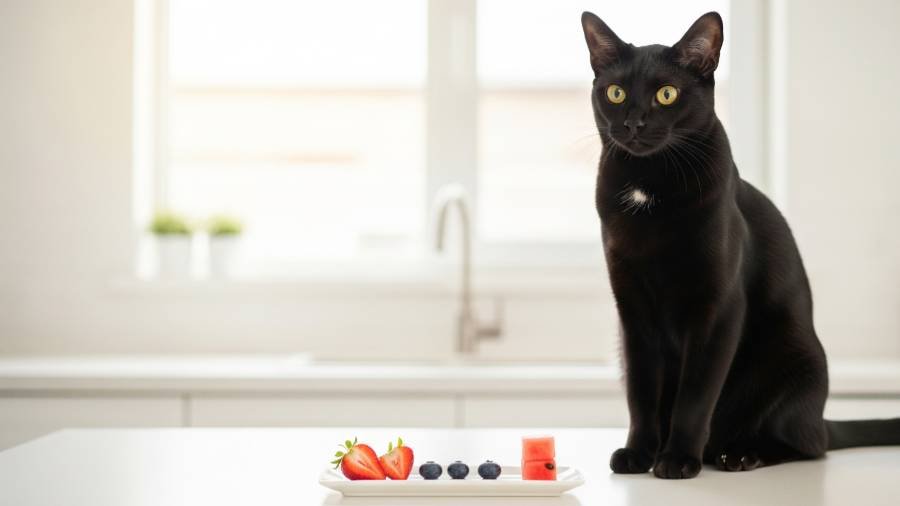
Cats: Obligate Carnivores with Limited Sweet Taste Receptors
Cats are obligate carnivores. This means their physiology and nutritional needs are specifically adapted to a diet mainly composed of animal protein.
Their digestive system is shorter and more acidic, designed to efficiently process meat. Interestingly, cats have limited sweet taste receptors, so they cannot taste sweetness in the same way humans do.
This suggests that sweet foods like fruit are unlikely to hold much appeal for them.
Safe Fruits for Cats in Small Amounts
Even though cats don’t crave sweet flavors, some fruits are safe for them to consume in moderation and can even offer some nutritional benefits. Always ensure fruits are properly prepared by washing them and cutting them into small pieces to prevent a choking hazard.
Blueberries
Blueberries are a safe and healthy treat for cats. They are a good source of vitamins, antioxidants, and fiber. Some cats might enjoy the small, bite-sized pieces and the slightly tart flavor.
Strawberries
Strawberries are another fruit that is generally safe for cats. They contain Vitamin C and antioxidants. Make sure to remove the green tops and cut into small pieces before feeding them to your feline friend.
Bananas
Many cats enjoy the soft texture and mild flavor of bananas. They are a good source of potassium and Vitamin B6. Offer only a small amount as they are relatively high in sugar.
Watermelon
Watermelon is mostly water, making it a hydrating treat, especially during warmer months. Ensure you remove the rind and seeds before giving it to your cat. It’s best offered in small, seedless pieces.
Cantaloupe
Cantaloupe is another melon that is safe for cats in small quantities. It contains beta carotene, a precursor to Vitamin A, as well as Vitamin C.
Apples (Peeled and Seedless)
Apples are safe for cats as long as you remove the skin, core, and seeds, as apple seeds contain small amounts of cyanide, which is toxic to cats. Offer only a small bite-sized piece.
Peaches (Pit Removed)
Ripe peaches, with the pit completely removed, can be given to cats in very small amounts. The pit contains cyanide and is toxic to cats. The fleshy part offers some vitamins.
Mango (Pit Removed)
Similar to peaches, mango is safe once the pit is removed. The flesh is sweet and contains vitamins. Offer only a tiny piece due to its high sugar content.
Cranberries
Some cats might tolerate a small amount of plain, cooked cranberries. They are known for their potential benefits for the urinary tract. However, their tart taste might not appeal to all cats.
Blueberries
As mentioned earlier, blueberries are a safe and good source of vitamins and antioxidants for cats. Their small size makes them less of a choking hazard when offered in moderation.
Fruits to Avoid Feeding Your Cat
Certain fruits are harmful and even toxic to cats and should never be given to them.
Grapes and Raisins
Grapes and raisins are highly toxic to cats and can cause kidney failure, even in small amounts. Avoid them completely.
Citrus Fruits (Oranges, Lemons, Limes, Grapefruit)
While not typically deadly, citrus fruits can cause digestive issues in cats due to their citric acid content. The strong smell might also be unpleasant for them. You can explore more about oranges at: can cats eat oranges.
Cherries (Pit and Stem Removed)
The flesh of a ripe cherry is not highly toxic, but the pits, stems, and leaves contain cyanide and should be strictly avoided. Given the risk, it’s best to avoid cherries altogether.
Avocado
Avocado contains persin, a fungicidal toxin that can cause digestive upset in cats. While generally not fatal, it’s best to avoid feeding avocado to your feline friend.
The Role of Fruit in a Cat’s Diet
It’s crucial to remember that cats are obligate carnivores. Their primary dietary needs are met by animal protein. Fruits should only constitute a very small portion of their overall intake, if at all.
The nutritional benefits they receive from the small amounts of safe fruits are minimal compared to the essential nutrients they get from high-quality cat food.
Many fruits are high in sugar, which can contribute to weight gain, dental problems, and potentially diabetes in cats, especially if given regularly. Their digestive system is not designed to process large amounts of sugar.
How to Introduce Fruits to Your Cat
If you decide to offer your cat a small piece of safe fruit, follow these guidelines:
- Wash Thoroughly: Always wash the fruit to remove any pesticides or dirt.
- Peel When Necessary: Remove peels, rinds, and cores.
- Remove Seeds and Pits: These can be toxic or pose a choking hazard.
- Cut into Small Pieces: Offer only bite-sized pieces to prevent choking and aid digestion.
- Introduce Slowly: Start with a tiny amount to see how your cat reacts.
- Monitor for Digestive Issues: Watch for any signs of vomiting, diarrhea, or loss of appetite.
- Offer Infrequently: Fruits should be occasional treats, not a regular part of the cat’s diet.
Alternatives to Fruit for Treats
There are many cat-specific treats available that are formulated to be nutritionally appropriate and palatable for cats. Small pieces of cooked, plain meat like chicken or fish (such as can cats eat salmon or can cats eat tuna) can also make healthy and enjoyable treats for your feline companion. You can also explore if can cats eat eggs as another protein-rich option.
Consulting Your Veterinarian
Before introducing any new human food into your cat’s diet, it’s always best to consult with your veterinarian. They can provide personalized advice based on your cat’s specific health needs and dietary requirements. They can also offer guidance on appropriate treat options and portion sizes.
Remember that a balanced diet is crucial for your feline friend’s overall health and well-being. Understanding what human food can cats eat requires careful consideration of your cat’s carnivorous nature.
While some fruits are safe for cats to eat in very small amounts, they should never form a significant part of their diet. Cats are obligate carnivores, and their primary nutritional needs are met by animal protein.
The high sugar content in many fruits can also pose health risks. Always prepare fruits safely by removing peels, seeds, and pits, and by cutting them into small, bite-sized pieces.
Monitor your cat for any digestive issues after introducing a new fruit.
When in doubt, always consult with your veterinarian about the best and safest ways to feed your cat and to understand what fruits can be a very occasional treat for your feline friend.
